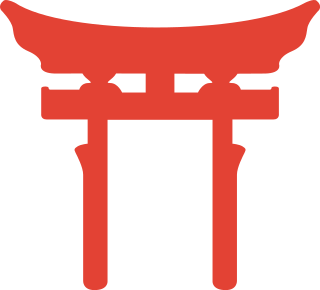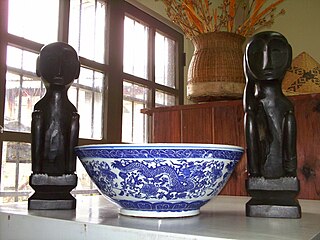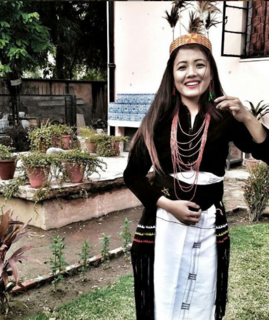
Kami are the spirits, phenomena or "holy powers" that are venerated in the religion of Shinto. They can be elements of the landscape, forces of nature, as well as beings and the qualities that these beings express; they can also be the spirits of venerated dead people. Many kami are considered the ancient ancestors of entire clans. Traditionally, great or sensational leaders like the Emperor could be or became kami.

Kaharingan is an animistic folk religion professed by many Dayaks in Kalimantan, Indonesia; particularly Central Kalimantan, although many have converted to Christianity or Islam or follow a syncretic religion. It is estimated that most Dayaks follow their ancient animistic religious traditions (Kaharingan), but often claim to belong to one of the recognized religions in Indonesia to prevent discrimination.

The Batak are one of about 140 indigenous peoples of the Philippines. They are located in the northeastern portions of Palawan, a relatively large island in the southwest of the archipelago. Since ancient times, the Batak have inhabited a series of river valleys along the coastline of what is today Puerto Princesa City.

Philippine mythology is the body of stories and epics originating from, and part of, the indigenous Philippine folk religions, which include various ethnic faiths distinct from one another. Philippine mythology is incorporated from various sources, having similarities with Indonesian and Malay myths, as well as Hindu, Muslim, Shinto, Buddhist, and Christian traditions, such as the notion of heaven, hell, and the human soul. Philippine mythology attempts to explain the nature of the world through the lives and actions of heroes, deities, and mythological creatures. The majority of these myths were passed on through oral tradition, and preserved through the aid of community spiritual leaders or shamans and community elders.

Filipino shamans, commonly known as Babaylan were shamans of the various ethnic groups of the pre-colonial Philippine islands. These shamans specialized in communicating, appeasing, or harnessing the spirits of the dead and the spirits of nature. They were almost always women or feminized men. They were believed to have spirit guides, by which they could contact and interact with the spirits and deities and the spirit world. Their primary role were as mediums during pag-anito séance rituals. There were also various subtypes of babaylan specializing in the arts of healing and herbalism, divination, and sorcery.

Indigenous Philippine folk religions are the distinct native religions of various ethnic groups in the Philippines, where most follow belief systems in line with animism. Generally, these indigenous folk religions are referred to as Anitism or Bathalism or the more modern and less Tagalog-centric Dayawism.

The Tagbanwa people are one of the oldest ethnic groups in the Philippines, and can be mainly found in the central and northern Palawan. Research has shown that the Tagbanwa are possible descendants of the Tabon Man, thus making them one of the original inhabitants of the Philippines. They are a brown-skinned, slim, and straight-haired ethnic group.

A weather god, also frequently known as a storm god, is a deity in mythology associated with weather phenomena such as thunder, lightning, rain, wind, storms, tornados, and hurricanes. Should they only be in charge of one feature of a storm, they will be called after that attribute, such as a rain god or a lightning/thunder god. This singular attribute might then be emphasized more than the generic, all-encompassing term "storm god", though with thunder/lightning gods, the two terms seem interchangeable. They feature commonly in polytheistic religions.

Indigenous Philippine shrines and sacred grounds are places regarded as holy within the indigenous Philippine folk religions. These places usually serve as grounds for communication with the spirit world, especially to the deities and ancestral spirits. In some cases, they also function as safeguards for the caskets of ancestors, as well as statues or other objects depicting divine entities.

Souls in Filipino cultures abound and differ per ethnic group in the Philippines. The concept of souls include both the souls of the living and the souls or ghosts of the dead. The concepts of souls in the Philippines is a notable traditional understanding that traces its origin from the sacred indigenous Philippine folk religions.

The Maring are one of the oldest tribe and ethnic group inhabiting Manipur State in North-East India. Their name is derived from mei meaning fire and ring meaning to start or produce. The people of Maring tribe are called Maringa. A mainly Christian people, they live chiefly in Tengnoupal district, Chandel and some places like Imphal, Senapati and so on.

Youdu in Chinese mythology is the capital of Hell, or Diyu. Among the various other geographic features believed of Diyu, the capital city has been thought to be named Youdu. It is generally conceived as being similar to a typical Chinese capital city, such as Chang'an, but surrounded with and pervaded with darkness.

Anito, also spelled anitu, refers to ancestor spirits, nature spirits, and deities in the indigenous Philippine folk religions from the precolonial age to the present, although the term itself may have other meanings and associations depending on the Filipino ethnic group. It can also refer to carved humanoid figures, the taotao, made of wood, stone, or ivory, that represent these spirits. Anito is also sometimes known as diwata in certain ethnic groups.
In the Philippines, a handful of superstitious beliefs exist that are very famous amongst the natives. These beliefs are typically introduced to them at a very early age through children's books or bedtime stories. It is believed that if natives aren't careful to follow them, a curse will befall upon them.










